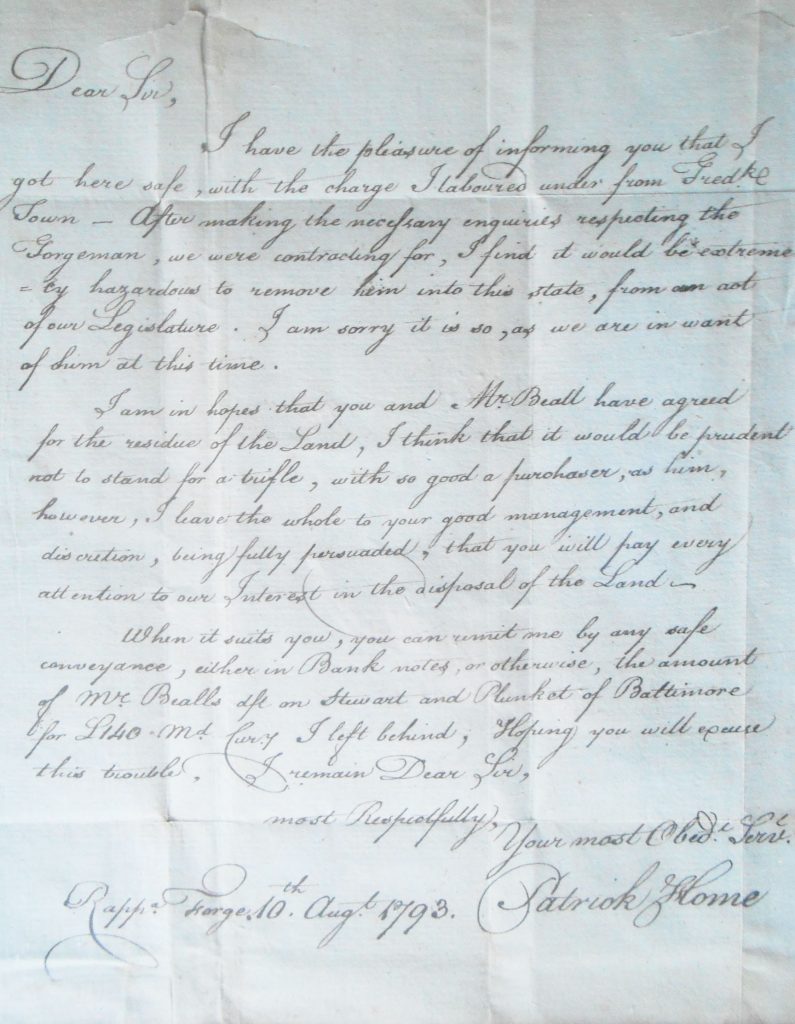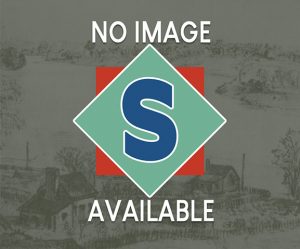Hunter's Iron Works
James Hunter’s Iron Works, also known as Rappahannock Forge, was located east of Falmouth. It was Stafford’s major industrial enterprise and one of Virginia’s and America’s early major industrial plants. Hunter’s large complex ran from today’s Old Forge neighborhood, south to the Rappahannock River, and east underneath I-95, to the Carter’s Crossing Shopping Center.
Hunter’s forge and blast furnace was the largest in Colonial America. In the Revolution, it produced weapons and implements for the Continental Army and Navy. The complex contained a blast furnace and forge; slitting, hammer, merchant, wire, plating, grist, saw, and steel mills; naileries and tanyards; carpenter, cooper, smith, and wheelwright shops; coal houses; stables; storage buildings; and quarters. It was considered the largest iron works in the colonies. Hunter and his iron works were credited with significant contributions to the cause of American independence. Yet, in 1783, Hunter paid taxes on some 260 enslaved persons — the pragmatic Scotsman did everything possible to increase production for the Revolution, including using enslaved labor. Thus, while Hunter’s enslaved persons ultimately helped win the war for independence, its victory eluded and excluded them for two more centuries. (Today’s location is called Olde Forge.)
During the Revolutionary War, the Iron Works produced weapons and implements for the Continental Army and Navy. Historians say that had it not been for the many items produced in Hunter’s Iron Works, America may not have won the Revolutionary War.
The massive complex contained:
- A blast furnace
- Forge 128 x 51 feet; eight fires and 4 hammers (The above picture shows a worker pouring pig irons.)
- Coal house 40 x 80 feet
- Merchant mill 36 x 70 feet, grist mill 18 x 20 feet, saw mill 11 x 55 feet
- Stable 27 x 54 feet
- A nailery, a tanyard; coopers, carpenters, and wheelwright shops
- Houses for the managers and workmen
- Storage buildings
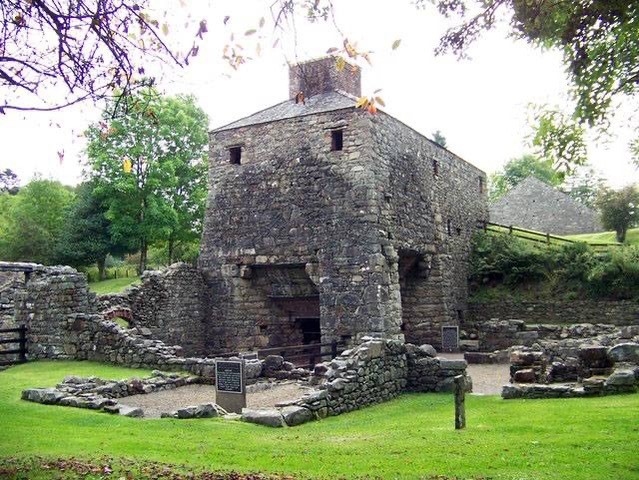
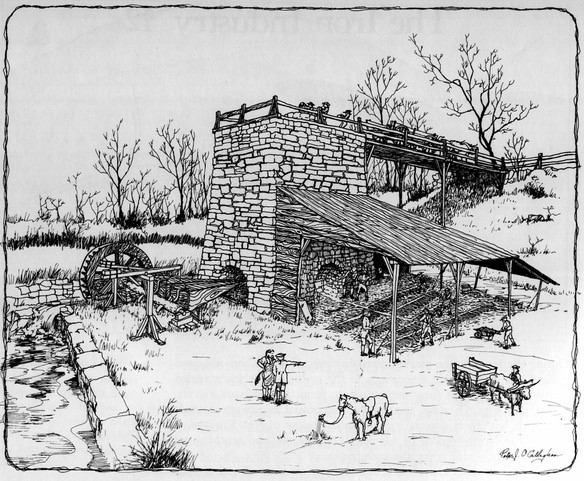
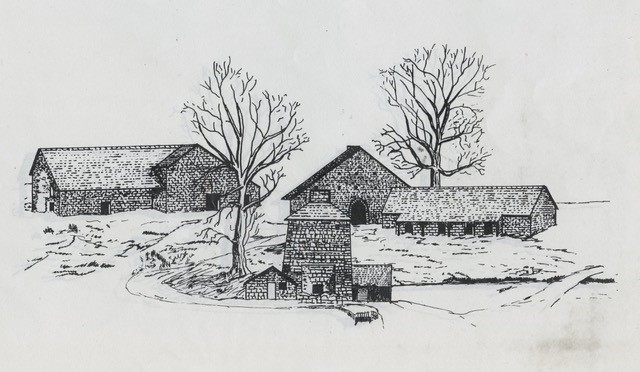
From Jerrilynn Eby MacGregor on the remains of Hunter’s Iron Works:
We know the dimensions of a few of the buildings and he used these as a basis for his drawing. He wasn’t at all comfortable with the perspective but knows that Manfred will be able to clean that up. The terrain here is critical to the layout of the structures. Running parallel to the river is a narrow flat flood plane about 30 feet wide. Along this are the canal, 3 tailraces, and a number of building foundations. The canal is 4,300 feet in length, just over 3/4 of a mile. About two-thirds of the upper part of the canal is 35′ in width, the lower third narrows to 16 feet in width, and the total fall between the upper end and the tail races is 19 feet. The hydraulics here were impressive to say the least. Behind the flood plane is a long ridge that’s about 40 feet high. I believe Hunter’s amazing 300 foot-long, 4 story armory stood on the lower end of the tract and below the last of the tail races–it’s the only place large enough to have held such a structure. Between the armory and the high hill the old road that ran between the forge and Falmouth is still clearly visible. The clerk who worked in the armory during the Revolution wrote a description of the building. He said that the water-powered gearing was on the lower level. The manufacturing was done on the second floor. There would likely have been a jack shaft running the length of the building to power individual pieces of equipment and we included a number of windows on this floor to provide light for the workmen. There were also forges in this building (I suspect they were on this floor, as well, since the clerk didn’t say anything about them being down with the gearing), thus the chimneys we included in Rick’s sketch. Some of the workmen were lodged on the third floor and finished goods were stored up on the fourth floor awaiting shipping. These folks would not have carried heavy crates of guns, tools, supplies, etc. up to the fourth floor if they were going to have to bring them back down to load them on wagons. It would also have been counter productive to have blocked the narrow road with wagons being loaded or unloaded. I strongly suspect that the finished goods were on the top floor because there was a bridge built out of the back side of the building and the crates were carried across the bridge to wagons waiting on top of the hill. I don’t think it’s a coincidence that a four-story building is about 40 feet tall, the same height as that hill.
All 18th century blast furnaces were nearly identical in size and shape and were constrained to certain dimensions because of the fragile nature of the charcoal that fueled them. They were built of stone or brick and given the abundance of granite in this area, I would expect Hunter’s furnaces to have been built of this material rather than of brick. I might be wrong, but there’s my guess. The furnaces were normally 25-28 feet in height and about 24 feet square at the base. The chimney stack was about 15 feet square at the top. I throw in this information to help with the scale and perspective of Manfred’s drawing. There appear to have been two blast furnaces at Hunter’s and Rick included these in his sketch. Typically, they were built into the hillside so that the opening on the back side of the chimney stack (into which were dumped the ore, fuel, and flux) was level with the top of the hill. There was usually a long roofed structure up against that side of the chimney in which could be stored the ore, charcoal, and flux. It was critical that these items be kept absolutely dry as the slightest bit of moisture could cause the furnace to explode.
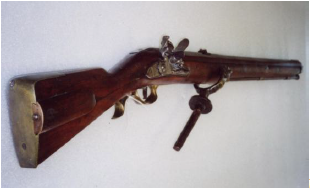
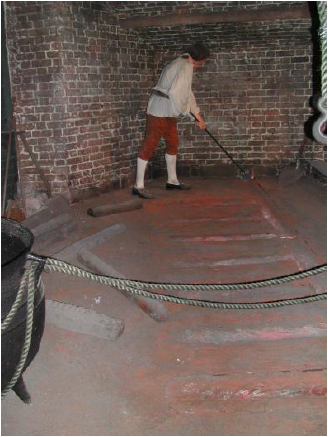
Stafford’s Hunter’s Iron Works, its relation to other Virginia iron industries, and its aid to the Revolution, is a fascinating parts of Stafford’s history. Local historian Jerrilynn Eby MacGregor relates: “Off the highways of America, are scores of crumbling monuments that recall this country’s stark beginning. These are the remains of venerable furnaces where iron ore was smelted to shape the destiny of America…”
In 1777 the legislature, backed by Governor Patrick Henry, recognized Hunter’s Iron Works, also known as Rappahannock Forge, by subsidizing plant expansion. By the end of the following year, the works included steel and brass furnaces; a new iron furnace; wire, plating and slitting mills; grist mills; forges; and a saw mill. The manufacturing mills were described as “one for making iron for the army and navy; one for fashioning arms, entrenching tools, and anchors; one for splitting and plating iron; and another for producing wire.” A British customs officer had already described Hunter’s facility as “the greatest iron works that is upon the Continent.”
Governor Thomas Jefferson wrote Hunter in 1781 indicating his concern for the works’ safety asserting “its significance to the safety of the colonies.” Virginia moved to secure the works. A state debt to Hunter for 180,000 Pounds (the modern equivalent of $800,000) attests to production-levels at the works and the value of Hunter’s muskets, wall-guns, swords, and equipment. Prior to 1781, state officials paid substantial amounts to James Hunter, though it is unclear exactly how much he was owed. After 1781 the General Assembly, essential broke and unable to pay its bills, failed to issue full payment on Hunter’s outstanding warrants.
Far from being destitute at his death, Hunter actually held substantial assets including his plantation house, “Stanstead,” some 6,000 acres of land in Stafford (and additional acreage in other places) and numerous enslaved persons. Due to non-payment of bills owed him by the state, his estate was burdened with substantial debts, but the exact balance is unknown. Regardless of his financial situation, his contributions to the Revolution were great and personified the 1776 Philadelphia pledge committing “our Lives, our Fortunes, and our sacred Honor.”
The man behind the success of Hunter’s Iron Works was actually John Strode, a Pennsylvania Quaker who managed the manufactury from c.1760 until c.1779 when he moved to Culpeper. Strode, a millwright and engineer, was responsible for much of the design and building carried on at Rappahannock Forge prior to the Revolution. James Hunter died in 1784 and the Revolution officially ended shortly afterward. Production continued at the works on a greatly reduced scale. Numerous attempts by the heirs to sell the property were unsuccessful. Not until the early 19th Century did Falmouth businessman Joseph Ficklen purchase the property. It is not known whether iron smelting resumed, but the forge and merchant mill continued in operation and Ficklen used parts of the works for his flour mills. Though heavily damaged by flooding, Union occupation, and time, many foundations remain on the forge site as does most of the three-quarters-mile-long canal that directed water from the river to the manufacturing mills. In 2001-2002, the Stafford County Historical Society purchased a Virginia Historical Marker to commemorate the “famous” Hunter’s Iron Works, ironically so perilously close to oblivion.
Representative of Stafford’s revolutionary symbolism was John De Baptist. A free black from the island of St. Kitts and nearby Spotsylvania County, he was one of as many as 10 Afro-Virginians who served on the Dragon, launched October 1777 to patrol the Rappahannock and Chesapeake. From the late war years until his death in 1804, DeBaptist operated a Falmouth ferry. His later “Publick Claim” sought recompense for 8 days of transporting French troops across the Rappahannock at Falmouth in May 1783.
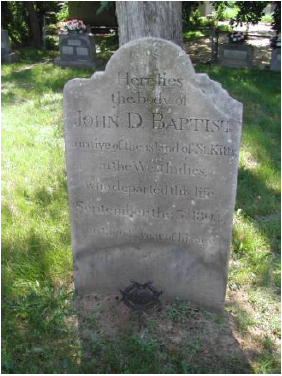
Irony persisted. James Hunter, an enslaver, had sacrificed everything in the cause of independence. Never adequately compensated for his efforts, he died in weakened financial condition. Hunter’s grave marker, either by design or accident, is a fence-enclosed tree. And free black DeBaptist, owner of considerable property when he died, was able to afford a finer tombstone. Regardless, they lie buried, close to one another in Falmouth’s Union Church Cemetery, where both have been honored by Revolutionary heritage groups.
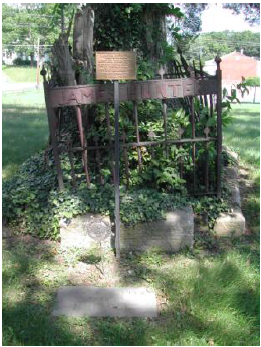
Apocryphal stories abound that he died penniless and was buried at night to avoid creditors, but these appear incorrect. It is unlikely creditors would have dug up his body for retribution, and the wrought iron fence wouldn’t have kept out anyone. Persistent stories James Hunter had “died a pauper” and was unceremoniously buried in Union Cemetery, Falmouth, led a group of citizens during the 1976 U.S. Bicentennial Celebration to hold a memorial service for the Revolutionary War patriot and industrialist.
